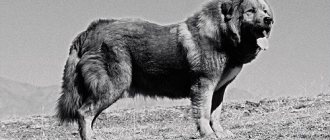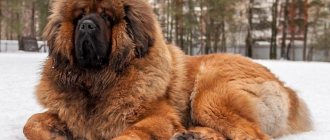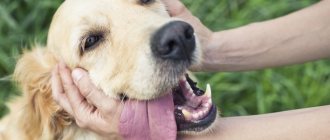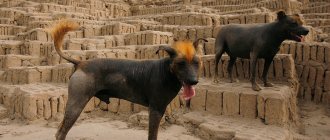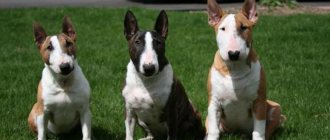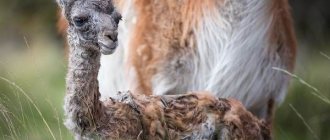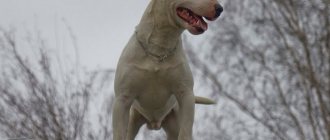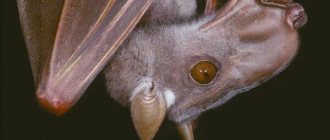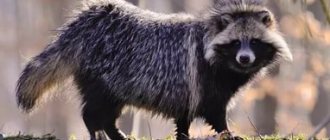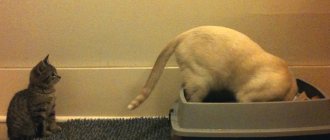Breed characteristics
| Short description | |
| Origin: | Tibet |
| Conditions of detention: | Apartment, house |
| Purpose: | Decorative dog, companion dog |
| Color: | All kinds of two-color combinations and single-color colors |
| Wool length: | Long |
| Adult dog size: | Height – up to 27 cm, weight – 4.5-8 kg |
| Average life expectancy: | 10-16 years |
| Walk: | Walking twice a day is recommended |
| Physical activity needs: | Low physical activity needs (walk 40-50 minutes per day) |
| Fédération Cynologique Internationale (FIC) classification: | Group 9: Toy and companion dogs; section 5: Tibetan breeds |
| Puppy price: | From 5 to 200 thousand rubles. Without pedigree – 5-10 thousand rubles; pet class – 12-25 thousand rubles, breed class – from 30 thousand rubles, show class – from 45 thousand rubles |
History of the origin of the species
The breed is oriental, so little is known about its origin; the birth of the Shih Tzu is shrouded in legends and myths. Genetically, the dog is very similar to the wolf, which confirms its antiquity. According to the official version, dogs appeared in Tibet even before our era (about 500), they helped monks by guarding their homes. There is also an opinion that they were first found or bred in Byzantium, and then transported to the east.
There is a legend that Shih Tzus were Buddha's pets. He never left his palace without these dogs, because in case of any danger, the animals grew up and turned into formidable lions. For this they were nicknamed “lion dogs.”
Another name that the breed bears is Chrysanthemum. It is caused by straight hair growth on the face. In general, the Shih Tzu is considered the third longest coat relative to the body.
According to the official version, the Dalai Lama presented the puppy to the Chinese emperor as a gift.
This happened around 1652 , from which time the cultivation of the breed began. Although until the 18th and 19th centuries dogs were considered exclusively royal dogs, commoners were deprived of their lives if they decided to have such a lion cub.
In 1938-1939, a Shih Tzu girl was presented to the Norwegian Ambassador. From this time on, the popularization of the breed began in Europe. The first breed club appeared in 1933 1934 , and a standard was written in 1948 .
How to care for a Shih Tzu
To make it less of a hassle for the owner, you can trim your Shih Tzu like a puppy, this will save you from daily brushing. If the dog is expected to participate in shows and exhibitions, then the coat must be kept long and silky by combing it daily. Its structure resembles human hair, so it requires careful care. When changing from a puppy's coat to an adult's one, the amount of brushing should be increased.
Care includes:
- Trimming nails, trimming fur between toes.
- Pull hair away from the eyes into a ponytail on the top of the head.
- Wash as needed, be sure to dry completely with a hairdryer.
- Make sure that no tangles form on the wool.
- Check the condition of your eyes, wipe them daily with clean cotton pads moistened with boiled water.
- Keep your nasal passages clean.
It is better to comb the dog before washing it. To keep the fur coat soft and shiny, the shampoo must be professional. Place a rug at the bottom of the bathtub or basin to prevent the dog's paws from slipping.
Distinctive features
A truly imperial dog, self-possessed, proud, beautiful. The format is elongated, with short legs and short stature: according to the 2011 standard, Shih Tzus should not exceed 27-28 cm. The weight of dogs can vary from 4.5 to 8 kg, with 7.5 kg being preferred.
In general, the dogs are well built and muscular. Males are always larger and stronger, females are more sophisticated. The breed is sometimes confused with the Lhaso Apso, an oriental breed that resembles the Japanese Chin and Shih Tzu in appearance. The dogs have similar proportions and coats, but are genetically completely different.
There are three intrabreed varieties: Scandinavian type (standardized), European and American. The first two species have practically no differences, but the American Shih Tzu is more like a separate breed. They have a small head, elongated limbs, a short tail and a flat chest. They are quite mobile, unlike standard dogs.
- The head is large, wide, round with a pronounced stop.
- The muzzle is shortened, flat, wide and square. The bridge of the nose is either straight or upturned. The jaw is strong with a scissor bite (upper teeth overlapping the lower teeth) or level bite . Lips are thin.
- The nose is in line with the lower corner of the eyes. Small, black or brown. The nostrils are wide and open.
- The eyes are set wide, not high. Rounded, not convex. Black or brown.
- The ears are large, triangular, drooping and fit tightly to the head. Not set high.
- The body is elongated, with a straight, short back and a wide loin. The chest is well dropped and wide. The croup is sloping. The neck is short, but the head is set proudly.
- The tail is set high, carried level with the head, carried over the back and well covered with long hair.
- The limbs are short, muscular, and set straight. The paws are round, gathered into a ball. The movements are proud and smooth.
- The coat is long, smooth (wavy is allowed), not silky, hard and dense. The undercoat is dense, but not fluffy. The fur on the face (near the nose) resembles a chrysanthemum, but does not interfere with the dog's vision.
- Colors: Any color is acceptable.
Varieties
This breed has three varieties, which you can get acquainted with later in the article.
Scandinavian (English)
They are distinguished by the presence of a large head, a high tail, a wide chest and an elongated lumbar region. Most often, such dogs can be found in Scandinavian countries, Ireland, Great Britain, and the Russian Federation.
European
This type is characterized by a voluminous head, a well-defined thoracic region, elongated limbs, and a short torso. These Shih Tzus are common in Canada, Australia and almost all of Europe.
American
When compared with the two previous types, such dogs are very often mistaken for a separate breed altogether, due to the presence of the following features: small head, shortened muzzle, flat chest, short body and tail, rather long limbs. The animal is characterized by excessive mobility. You can meet such representatives in both Americas, in the southeastern regions of Asia, in Russia and Belarus.
Photo of an adult dog
Photos of puppies
Features of character and behavior
The Shih Tzu is truly an imperial dog . He has manners and self-control, but the breed is not short of narcissism.
Dogs do not tolerate bad attitudes, rudeness, and are often jealous.
At the first meeting, the pet may seem embittered or timid, unfriendly. But as you get to know the owner, the Shih Tzu reveals all its sociable qualities and becomes a good pet.
Representatives of the breed are active, but do not require much physical activity. In addition, they are unobtrusive, patient, and know how to wait, but they will demand a reward for this. In general, these dogs are suitable even for a beginner.
Advantages
The advantages of the breed include:
- Good nature, lack of aggression;
- Love for children, tolerance for other pets;
- Aristocratic;
- Unobtrusiveness;
- Loyalty and affection towards the owner and family;
- Good attitude towards strangers;
- Silence (Shih Tzus are silent, they do not bark over trifles or whine);
- Dogs do not require high physical activity, although they are active and playful.
Flaws
Each owner determines the shortcomings individually. The character of a pet often depends on its upbringing and living conditions. If the puppy is not beaten, if he is socialized and exercised, then he will become a good pet without attacks of aggression or excessive timidity. The main breed disadvantages include:
- Narcissism (Shih Tzus always demand attention to themselves);
- Zealous attitude towards the owners;
- Intolerance of loneliness and long separations from the owner;
- Demandingness (the dog will not lag behind if the owner does not fulfill its request);
- Lack of protective instinct, excessive gullibility.
Diet
You can feed your Shih Tzu with natural or prepared food. The basis of the natural diet is raw or boiled beef, veal, horse meat, well-cooked offal, boiled or raw vegetables, a small amount of cereals, fermented milk products and some sea fish. Chicken is given carefully; it causes allergies in some dogs. They also provide supplements: seaweed, fish oil and complex vitamins. Ready-made feeds are selected depending on the physiological needs of each age group.
Having taken the puppy to a new home, for the first time he is fed the same food that the breeder gave him. Any changes in diet should be gradual. Any food that the puppy has never tried before is considered new. It is important not to overfeed your dog. Whatever she eats with appetite will be the optimal portion. The animal should always have clean drinking water freely available.
Care and maintenance
The breed is hypoallergenic because it does not shed and does not emit a specific odor. Dogs can only be kept indoors; their long hair requires constant care. In all other respects, the pets are unpretentious, can sleep with the owner, are not picky about food, and play all day long.
An animal can and should be trained to use a house toilet, but, as a rule, Shih Tzus do not like to go to the litter box and do not accept this condition well.
Before purchasing a pet, you need to think about where to place its bed. The place should not be subject to drafts or be exposed to direct sunlight. The best option would be a soft, warm lounger next to the owner’s bed. It is also worth buying items for daily use: bowls on stands, toys, hygiene products.
The ears and eyes are examined daily; the breed is prone to otitis media, so cleaning is carried out at least 3 times a week. Teeth are brushed every day to prevent periodontal disease from developing. Nails are trimmed every 2 weeks.
Nutrition
The breed is one of those that quickly gain weight, so cases of obesity are common, due to which the loaded limbs become deformed. Therefore, nutrition is one of the most important and strict points in caring for this breed.
Up to 3 months, the number of puppy meals ranges from 4 to 6 times a day. By the age of six months, puppies are transferred to three meals a day, and by one year the dog is accustomed to a two-time schedule. Usually, 300-400 grams of feed per day is enough. In summer the amount of food is reduced, and in winter it is increased. The serving size also depends on the physical activity and activity of the animal.
You can feed dogs both dry prepared foods and natural food. The choice depends on the owner’s preferences, the puppy’s health condition and the breeder’s recommendations. Recently, dog breeders prefer ready-made food. It contains all the necessary minerals and vitamins and is easy to store, transport and use.
Low-quality products can harm your pet, so before using any brand, you need to consult a veterinarian or breeder and read reviews.
It is important to check the composition of the feed; it should not contain emulsifiers, millet, legumes or starch. Shih Tzus will benefit from super-premium products for short (small) breeds with medium to low activity. The best option would be holistic (grain-free).
Natural nutrition should be comprehensive. It is considered useful, because the owner cooks it himself and knows what ends up in the pet’s bowl. Of course, this type of feeding is financially and time-consuming. The diet must include meat products (about 40% of the menu): offal, poultry, lamb, rabbit, beef.
The pet also needs other proteins: eggs, boiled sea fish, fermented milk products. Dogs get carbohydrates from cereals and cereals (30% of the diet): buckwheat, rice and oatmeal, boiled in broth or water . From childhood, puppies are taught to eat vegetables and fruits.
We recommend that you read a detailed article on the topic: “How and what to feed a dog: types and characteristics of nutrition.”
Taboo foods:
- Pork;
- Vegetable oil and butter;
- Bones (any);
- Bakery and confectionery products;
- Fried, smoked;
- River fish;
- Legumes;
- Starchy vegetables and fruits (potatoes, melon, grapes).
It is strictly forbidden to feed the dog from the table, leftover human food. Mixing dry and natural food is not allowed. Transferring a pet to another type of food is carried out smoothly: first the animal is fed, then one meal is replaced, and later the transfer is complete. The process should take 1.5-2 weeks.
You need to monitor your drinking regime; clean water should always be in a bowl. If the puppy does not drink on his own, he is given water from a spoon or syringe.
Shih Tzus have a short muzzle and a snub nose, so when they drink, their nasal passages can become clogged and interfere with breathing. It is important to check the muzzle after each drink of water.
Health
Shih Tzus are long-lived, with proper care and quality feeding they can live up to 17 years, although the average life expectancy is 10-16 years.
They are not particularly painful, although there are some breed diseases that are common to all individuals. Problems are associated with the non-standard structure of the body and muzzle.
Vaccinations
Even a domestic decorative dog that does not leave the house needs vaccination. A person can carry viruses on themselves that will destroy the pet’s immune system.
Puppies under one year of age are especially susceptible to viruses, because after two months their immunity, given to them by their mother, ceases to function.
Although vaccination only provides 60-70% protection, it helps dogs recover.
Unvaccinated animals cannot tolerate the disease and treatment, therefore, most often they die or require constant administration of medications.
Primary vaccination is carried out by the nursery. The breeder will inform the future owner about the dates and medications and issue a veterinary passport where the vaccinations will be entered. The owner must continue to follow the vaccination schedule.
Complex vaccination is carried out at 2, 2.5, 6, 12 months . It provides immunity from pyrotitis, enteritis, leptospirosis, plague and other viral diseases.
Annual repetition is mandatory, because the effect of the drug does not last forever.
Another important vaccination is against rabies. It is carried out at 7 months and repeated annually. In addition to the protective function, vaccination also has a registration character. A pet cannot be transported across the border unless it has been vaccinated with two vaccines in the last 12 months.
It is important to follow several rules so that the procedure goes smoothly.
- First of all, you should not walk your pet until the second vaccination.
- It is necessary to observe quarantine after each vaccination (2 weeks).
- 14 days before vaccination, the pet is dewormed with medication.
All vaccinations are carried out in veterinary clinics by experienced specialists. In case of an allergic reaction, the animal is immediately injected with a counteracting substance. If side effects occur for more than one day, you should contact your veterinarian.
Important article on the topic: “Everything you need to know about dog vaccinations.”
The cost of vaccination depends on the weight of the pet. As a rule, it varies from 400 to 1000 rubles.
Diseases
Diseases characteristic of the breed:
- Proptosis (prolapse of the eyeball, dislocation of the eyeball), the orbit in dogs is not closed, so the apples are supported only by the muscles; with any sprain, weakening or surge in pressure, the pet may “lose” an eye, in which case you need to urgently contact a veterinarian;
- Periodontal disease (bleeding gums);
- Tooth loss , abnormal growth of teeth (associated with a flat muzzle);
- Problems with the back and spine (due to short legs and a long massive body, it is not recommended to overload the pet);
- Paralysis.
Walk
Shih Tzus are active, but do not require frequent or long walks. Some individuals are not even allowed to walk, although this can negatively affect the health or emotional state of the pet. It is best to walk the dog 2 times a day for 20-30 minutes, without overloading with training or too active games.
Until a year old, the puppy is not allowed to go up and down steps or jump on high objects.
As socialization progresses, the puppy is accustomed to the street. After the second vaccination, you can start walking outside. For the first 3-4 days, the puppy is carried out in your arms, showing the surrounding space. Then they are taken out on a leash for 10-15 minutes. After a couple of weeks, you can take your pet to the park and introduce him to small dogs and people. The last stage will be a trip with the animal on public transport, a walk along a noisy street.
Grooming
Long hair requires constant careful grooming.
- First, brush your pet daily with a long-toothed brush and comb it with a furminator.
- Secondly, grooming, which is suitable for both show dogs and pets.
There are several types of haircuts.
- Exhibition - giving shape to the coat without removing length.
- Model - an original hairstyle with braids or interesting patterns.
- Standard – clipper haircut with elongated paws, tail and muzzle.
- Hygienic – removal of hair in the ears, anus, genitals and between the fingers.
You shouldn't bathe your pet often. The best option is 5 times a year , using gentle shampoos.
When the cover is contaminated, fungal diseases and dermatitis develop, so the dog needs to be accustomed to special protective clothing: raincoats, down jackets, anthers and light spring jackets.
In winter, the paws are corroded by the salt that is sprinkled on the ground, and in the summer the dog burns its pads on the asphalt, so shoes are a necessary accessory.
In summer and during the warm season, wool should be checked for the presence of fleas and ticks, and treated against parasites with suspensions or shampoos. Every 2 months, dogs are dewormed (cleansed from worms).
Feeding
The mini Shih Tzu breed, despite its small stature, loves to eat heartily, like a mini husky. Like all dogs, this dog is also a carnivore. His diet should consist mainly of meat. They should be diluted with cereal porridges, fiber, mineral and vitamin complexes.
If your pet is fed only natural products, then the dog needs the following diet:
- Low-fat meat products. They can be boiled or lightly fried in a pan. Give puppies 50g of meat per 1 kg of their weight, adults - 200-250g/day.
- It is advisable to give by-products boiled. But bone sets are prohibited.
- To replenish calcium in the body, it is useful to give your pet dairy products. For example, add low-fat cottage cheese to porridge. But milk is contraindicated for adults, as it can damage the stomach. Better - kefir, fermented baked milk.
- When it is necessary for the dog to gain a little weight, you can give it boiled eggs; absorption will be good. They won't do any good if they're raw.
- For cereal porridges, millet or rice are good options. Hercules flakes can be poured with fresh broth, infused a little and you can feed your pet. Oddly enough, buckwheat can cause allergies in Shih Tzus, so you should not give such porridge.
- Vegetables are given to the dog in any form.
It is not recommended to feed your Mini Shih Tzu any kind of baked goods, sweet foods or smoked foods. If you don’t have time to prepare food for your dog, you can use ready-made dry food. They can be purchased at a pet store. Dry food usually contains vitamin supplements. The portion is calculated based on the weight category and age of the dog.
Currently reading:
- Games to choose for training a dog
- The American Cocker Spaniel is an adroit hunter and loyal friend.
- Why does a dog bite and how to stop it from doing so?
- Tips for proper dog burial
Mating
Dogs are small and do not require much space. But inviting a specialist for the first time will make the work of the owners easier. Shih Tzus are unusual in structure, so they need help during the process. An ignorant person can injure a dog.
Breeding pets are brought together through a nursery, where owners fill out forms and receive certificates. Later they agree on the date and price, which is paid to the owner of the dog. Usually, it is equal to one puppy or a percentage of its cost.
Animals can be knitted at 2-2.5 years, although they mature at 8-10 months. The female should go into her third heat and show signs of readiness: loosening of the loop, light discharge, playful behavior.
Within two weeks, pets are checked at the veterinary clinic for pathologies and cleaned of worms. On the day of mating, the female is brought to the male. The animals are given time to get to know each other. When the male tries to mount, the girl is held by the head and is not allowed to mount. The dog is sent into the loop.
After several active pushes, a lock may occur in which the dogs stand for 10-15 minutes . It is important to place them so that they do not injure the genitals: tail to tail. Even without a lock, a girl can become pregnant . Mating is repeated after 48 hours , and the progress of pregnancy is checked at a veterinary ultrasound center.
Read a detailed article on the topic: “Everything you need to know about breeding dogs: appropriate age, what to do if it doesn’t work out, rules and tips.”
Breeding
For breeding work, mature animals are used, whose breed is documented by pedigree. It is in this case that the offspring will be considered representatives of the Shih Tzu breed.
At what age do they knit?
The optimal period for a dog to bear and give birth to puppies is considered to be the age of a bitch from one and a half to seven years. In order for conception to occur for sure, it is necessary to organize mating during the period of ovulation, which occurs at the end of estrus. Test strips used to detect sugar in the urine of diabetics will help to accurately determine it. The strip is inserted into the dog's vagina for a minute. If the color turns green, you can breed the dogs.
Caring for puppies
In the first three weeks, the bitch takes care of the newborn puppies herself. The owner must take good care of the dog during this period, and also ensure that the puppies have access to the nipples and receive the right amount of milk.
It is advisable that the mother feeds the babies for as long as possible. As long as they have enough food, they don't need complementary feeding. To determine this, babies are weighed every day. As soon as the weight gain stops, it is time to introduce complementary foods. It starts with cow's milk and chicken eggs, and from 20 days of age continues with liquid milk porridges.
Choosing a Shih Tzu is a responsible matter, sometimes it seems that it is not the person who chooses the dog, but the dog who chooses its owner
Gradually, minced beef and vegetable soups are being introduced into the menu. Upon reaching one month of age, food is flavored with vitamin and mineral supplements.
All this time, it is important to monitor the babies’ digestion - they should periodically defecate with yellow feces. If one of the puppies squeaks for a long time, he may have stomach problems or constipation and needs a massage. Usually the chrysanthemum mother herself monitors this and takes measures, but the owner should keep the situation under control.
At the age of one and a half months, puppies begin to develop teeth. This means that they are ready to undergo examination (certification) by experts in order to obtain puppy metrics. After two months of age, young chrysanthemums are ready to move to new owners. If you decide to keep the puppies, make sure they have their own place to sleep. The norm for changing teeth is 4–6 months.
Key points in training
Decorative breeds do not need training as much as they need education. The Shih Tzu is a wayward dog, sometimes stubborn, and difficult to train. But if you take care of your puppy from childhood, you can raise an easy-going and obedient pet.
Read about how to properly train a dog in the article: “Training a puppy: effective methods from dog handlers, learning commands at home.”
You cannot scold, offend, or beat a dog. For punishment, a strict intonation, a look, or deprivation of a treat will suffice. These dogs cannot live without attention, so ignoring can be used as a reprimand.
Your pet needs to remember a few rules. He should not beg, be stubborn, or ask for food until the owner and family have finished eating. You can enter the house only after a person, jump and sleep on furniture after permission.
A decorative dog needs to know several basic commands: “near”, “no”, “place”, “quiet”, “come”. It is extremely difficult to teach the breed circus tricks, but you can resort to the help of a dog handler.

